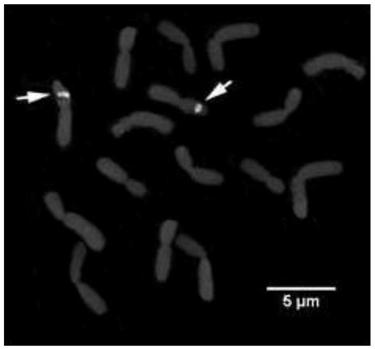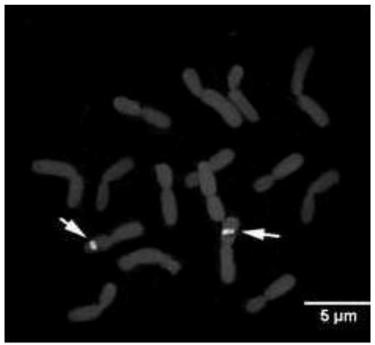FISH (fluorescence in situ hybridization) method of allium mongolicum regel chromosome
A fluorescence in situ hybridization and chromosome technology, applied in the field of cytogenetics and molecular biology, to achieve the effects of shortened culture time, strong fluorescent signal, and strong hybridization specificity
- Summary
- Abstract
- Description
- Claims
- Application Information
AI Technical Summary
Problems solved by technology
Method used
Image
Examples
Embodiment 1
[0045] This embodiment provides a method for fluorescence in situ hybridization of the Mongolian Chinese chives chromosome, comprising the following steps:
[0046] S1. Preparation of Mongolian leek chromosome slide specimen:
[0047] (1) Material collection: Take Mongolian leek seeds and place them in a petri dish with 2 layers of wet filter paper, add water and place them in an incubator at 22-25°C for 4-5 days, and the root tips of the seeds will grow to 0.6cm, which meets the requirements of The required range of the root tip of the seed is 0.5-1cm, and then cut the root tip of 1-2mm.
[0048] (2) Tablet preparation: put the excised root tip into a vial, add an appropriate amount of water, seal the cap, quickly place it in a mixture of ice and water at 0°C, and pretreat it in a refrigerator at 0°C for 20-24 hours.
[0049] (3) Fixation: Rinse the root tip after the above pretreatment, and fix it at room temperature (25° C.) for 12-24 hours with a freshly prepared Carnoy’s...
Embodiment 2
[0068] This embodiment provides a method for fluorescence in situ hybridization of the Mongolian Chinese chives chromosome, comprising the following steps:
[0069] S1. Preparation of Mongolian leek chromosome slide specimen:
[0070] (1) Material collection: Take Mongolian leek seeds and wash them with distilled water for 1-3 times, then soak them in the seed soaking solution for 0.5 hours, then place them in a petri dish with 2 layers of wet filter paper, add water and place them in a constant temperature box at 22- Cultivate at 25°C for 18 hours, the root tip of the seed grows to 0.8cm, which meets the requirements of the root tip of the seed in the range of 0.5-1cm, and then cuts the root tip of 1-2mm; Mixed aqueous solution of 25mg / L acetone.
[0071] (2) Tablet preparation: put the excised root tip into a vial, add an appropriate amount of water, seal the cap, quickly place it in a mixture of ice and water at 0°C, and pretreat it in a refrigerator at 0°C for 20-24 hours...
Embodiment 3
[0091] This embodiment provides a method for fluorescence in situ hybridization of the Mongolian Chinese chives chromosome, comprising the following steps:
[0092] S1. Preparation of Mongolian leek chromosome slide specimen:
[0093] (1) Material collection: Take Mongolian leek seeds and wash them with distilled water for 1-3 times, then soak them in the seed soaking solution for 0.5 hours, then place them in a petri dish with 2 layers of wet filter paper, add water and place them in a constant temperature box at 22- Cultivate at 25°C for 21 hours, the root tip of the seed grows to 0.6cm, which meets the requirements of the root tip of the seed in the range of 0.5-1cm, and then cuts the root tip of 1-2mm; Mixed aqueous solution of 40mg / L acetone.
[0094] (2) Tablet preparation: put the excised root tip into a vial, add an appropriate amount of water, seal the cap, quickly place it in a mixture of ice and water at 0°C, and pretreat it in a refrigerator at 0°C for 20-24 hours...
PUM
 Login to View More
Login to View More Abstract
Description
Claims
Application Information
 Login to View More
Login to View More - R&D
- Intellectual Property
- Life Sciences
- Materials
- Tech Scout
- Unparalleled Data Quality
- Higher Quality Content
- 60% Fewer Hallucinations
Browse by: Latest US Patents, China's latest patents, Technical Efficacy Thesaurus, Application Domain, Technology Topic, Popular Technical Reports.
© 2025 PatSnap. All rights reserved.Legal|Privacy policy|Modern Slavery Act Transparency Statement|Sitemap|About US| Contact US: help@patsnap.com



